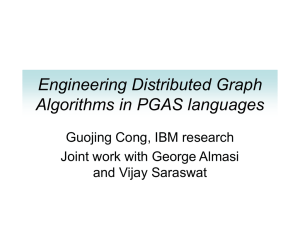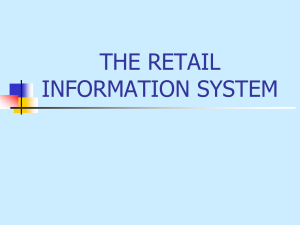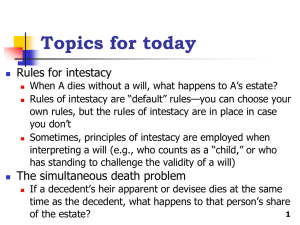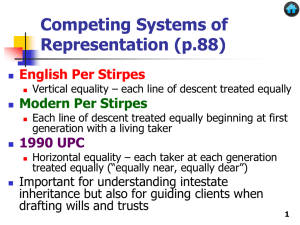phenix upc
advertisement
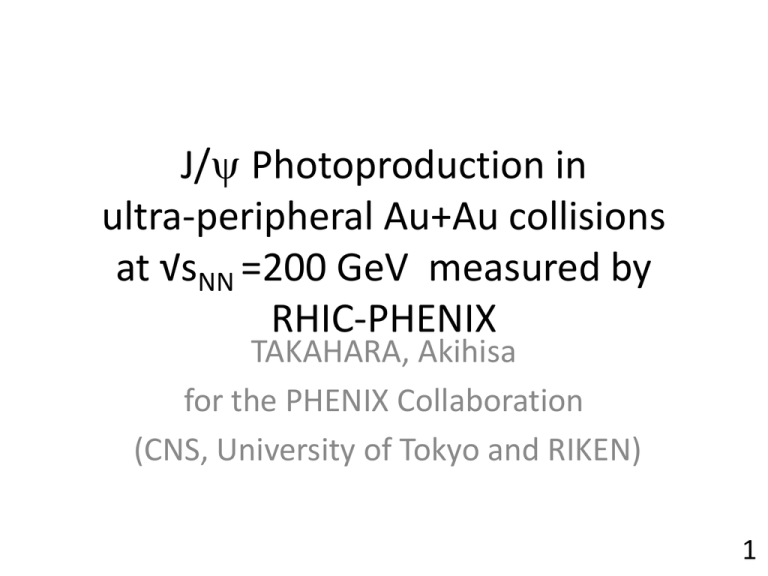
J/y Photoproduction in ultra-peripheral Au+Au collisions at √sNN =200 GeV measured by RHIC-PHENIX TAKAHARA, Akihisa for the PHENIX Collaboration (CNS, University of Tokyo and RIKEN) 1 Characteristics of Ultra Peripheral Collisions b>2R no nuclear overlap. Possibility to study g- induced reactions Coherence condition: wavelength > nucleus size . Very low photon virtuality Z 1e A b v~c b > 2R A Z 2e Weizsacker-Williams (EPA): • The electromagnetic field is equivalent to a large flux of quasireal photons, and can be calculated per (Fermi)-Weizsacker-Williams: RHIC max. photon Wggmax 6GeV energies(EPA):3 GeV~g/R WgNmax 34GeV RHIC, LHC LgA/LAA 2 Physics motivation for UPC J/y gluon distribution in Nuclei is not same free proton RHIC UPC J/y Q2=2.5GeV2 x~0.01 Theoretical predictions And 2004 result •Direct Measurement of gluon distributions at low-x •search for Nuclear shadowing 3 coherent and incoherent distribution Strikman, Tverskoy, Zhalov, PLB 626 p. 72-79、2005 •Strikman et al calculate that quasi-elastic (incoherent) J/y cross-section comparable to coherent production •Incoherent J/y produced from photo-nucleon interaction •Much larger t distribution expected for incoherent •Both process emit only J/y and neutron. pT distribution is important to divide them •Strikman’s predictions say at central rapidity, coherent process is dominant, but at forward rapidity, incoherent process is dominant at PHENIX n incoherent coherent n incoherent coherent 4 RHIC-PHENIX Luminosity Au+Au(200GeV) : 2 x 1026 [cm-2s-1] p+p (500GeV): 2 x 1031 [cm-2s-1] 2007-RUN •for central •AuAu •200GeV •~530/μb 2010-RUN •for forward •AuAu •200GeV ~800/μb Central arm (|y|<0.35) electron (using 2007 data) Forward arm (1.2<|y|<2.2) muon(using 2010 data) 5 Signal from UPC J/y and its trigger Coherent UPC n Signal from UPC J/y→ll 1. a lepton pair without any other tracks e+ 2. 50~60% UPC events are associated with nuclear break up e- PHENIX UPC trigger 1. BBC_VETO(reject nuclear overlap) 2. EMCAl(for central)/Muon track(for 50-60% forward) 3. ZDC detect at least a neutron BBC BBC(3<|y|<3.9) BBC is main vertex detector of PHENIX 1st condition means we can’t use it PHENIX MB :4kHz PHENIX ERT2x2(EMcal):8kHz to reduce trigger rate, 3rd condition was required 6 UPC J/y+Xn measurement at PHENIX Central arm(|y|<0.35,X>1) p e+ e- g + Offline analysis cuts 1. |collision vertex determined from tracks reconstructed in the PAD chambers|< 30cm 2. number of tracks==2 3. North or south BBC charge==0 4. energy deposit of ZDC>30GeV(just confirm there are no noise trigger) 7 UPC J/y+Xn(y>0)Yn(y<0) measurement at PHENIX Forward arm(X>1,Y>1) 5 interaction length→ to get vertex information, both side ZDC fire was required Offline analysis cuts 1. |vertex determined from ZDC|<30 cm 2. number of tracks==2 (in central and forward) 3. North or south BBC charge==0 4. energy deposit of ZDC>30GeV 1. Just noise cut 5. Both RXNP charge <1000a.u. 2010 run forward UPC mass dist (North 1.2_<y<2.2) Clear J/ψ peak 8 Real data for dielectron(|y|<0.35) Dimass distribution Unlike like ZDC energy dipT distribution pT(GeV/c) • Clear J/y peak • Only unlikesign pair (over 2 GeV) • Clear Coherent(low pT) peak 9 Real data for dimuon(1.2<|y|<2.2) North Unlike like dipT distribtuion 2.7 GeV<dimass<3.5 GeV North South South Unlike like • Clear J/y peak • Only unlike sign pair (2 GeV>mass) • Coherent(low pT) peak is not so clear • But still 0 pT peak 10 Neutron emission for dimuon J/y North ZDC South ZDC Dimuon North • Same side:1300GeV • Opp side :700GeV opp side Multi Photon excitation Dimuon South • If there was nuclear over lap, the asymmetry can’t be explained • Suggest UPC (incoherent) process Same side Multi photon excitation +Nuclear break up by recoiled neutron 11 Comparison with pp for dielctron Dimass distribution Unlike like dipT distribution Unlike Like ~1GeV/c peak Even pp(ncoll=1 limit), • J/y events are associated with additional tracks • At pT ~2.5 GeV/c, unlike/like~2 • UPC and PP J/y pT distribution is different Number of tracks in central arm UPC(without central track cut) PP Normalized at 2 12 Comparison with pp for dimuon Dimass distribution Unlike like dipT distribution Unlike like Even pp(ncoll=1 limit), • J/y events are associated with additional tracks • At pT ~2.5 GeV/c, unlike/like~2 • UPC and PP J/y pT distribution is different • Central multiplicity distribution suggest little most peripheral contamination • About 3 J/y per arm. Number of tracks in central arm(not muon arms) UPC(without central track cut) PP(0track/non 0tracks~30%) Normalized at 0 13 Contamination form diffractive process • Diffractive J/y should have just 2 tracks • UPC like events ! • Typically, diffractive collisions /all pp~30% • 10k J/y was generated by PYTHIA (pp 200GeV,msel2(minimum byas)) • 0/10k J/y was generated by diffractive process • Can be neglected 14 Background sources for dielectron(|y|<0.35) Rapidity distribution STARLIGHT simulation for gg->dilepton In central(|y|<0.35) region, γγ->dielectron is main background source “Simulated continuum curve +Gaussian” fit J/y gaus +trig,detecter Acc xeff(mass)x exp • Exp slope was fixed by simulation 15 Background sources for dimuon(|y|<0.35) • HERA:gp->J/y measurement y(2s)/J/y=7% Eur. Phys. J. C 24, 345–360 (2002) • gg->dimuon can be neglected this rapidity region • Expected most peripheral contamination • doesn’t have enough statistics to explain all background North dipT <0.5GeV/c J/y y(2s) Total background Background by UPC process are suggested • UPC ccbar • gAu->dipion->dimuon 16 Integrated cross section J/y +Xn Central 2004 & 2007 sys errors Acc(over all) 5% simulation 12% Lumi 4% ERT 0.2% Njpsi 1.4% BBC 1.6% 2004+2007 2004 PHENIX 76 31 (stat) 15 (syst) b 2007 PHENIX J. Nystrand, Nucl. Phys. A 752(2005)470c; A.J. Baltz, S.R. Klein, J. Nystrand, PRL 89(2002)012301; S.R. Klein, J. Nystrand, Phys. Rev. C 60(1999)014903 M. Strikman, M. Tverskoy and M. Zhalov, Phys. Lett. B 626 72 (2005) V. P. Goncalves and M. V. T. Machado, arXiv:0706.2810 (2007). Yu. P. Ivanov, B. Z. Kopeliovich and I. Schmidt, arXiv:0706.1532 (2007). 17 J/y+Xn Invariant Yield @(-0.35<y<0.35) theoretical calculations for Coherent (@y=0) •no shadowing 113μb •DS 10 μb •EKS 83μb •Kopeliovich GBW 61μb •Kopeliovich KST 54μb •EPS 53μb •Strikman impulse 40 μb •Strikman glauber 30 μb •We can see both coherent and incoherent distribution •46.7 ±13μb for pT < 0.4GeV(upper limit of coherent) •compatible with calculations including strong suppression of gluons at low x 18 J/y +Xn(y>0)Yn(y<0) •The pT distributions at forward rapidity shows that incoherent process is very visible at forward (can’t see coherent peak) •There are no theoretical predictions with XnYn condition 19 Summary and Outlook Summary • PHENIX measured J/ ψ photo-production yield and its pT dependence in a broad rapidity region. – characteristics of UPC signals is obviously different from pp • - J/ψ +Xn result at mid-rapidity is consistent with calculations suggesting strong gluon shadowing • - important contribution from incoherent processes in J/ψ+Xn(y<0)Yn(y>0) at forward rapidity, looking forward for calculations for this exclusive process Outlook • New vertex detectors will help in the further study of UPC events at RHIC. 20 21 22 23 24 gg->dimuon distribution • gg->dimuon distribution is very sharp in this region • Because of edge of detector, Acceptance x efficiency is very low at Y=1.2 25 Detail of fitting J/y gaus +trig,detecter Acc xeff(mass)x exp • Exps lope was fixed by simulation 26 Detail of fitting Divide into pT bins • Due to hadron suppresser Fitting function Acceff(dimass)x Gaus1(J/y) Gaus2(J/y tail) Gaus3(y(2s)) +exp(background) North dipT <0.5GeV/c J/y y(2s) Total background • Shape of gaus 1&2 was fixed to pp data • Gaus3/Gaus(1+2) is fixed to 7% 27



